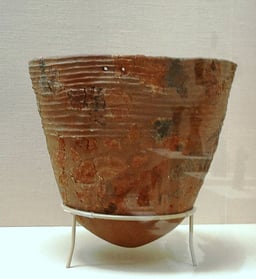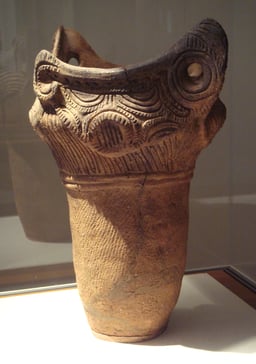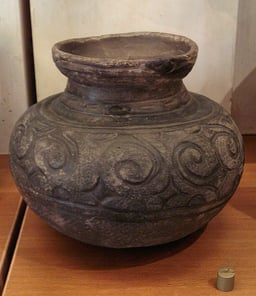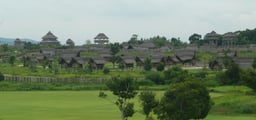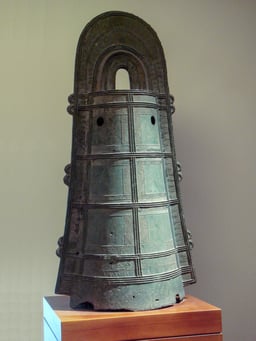History of Japan
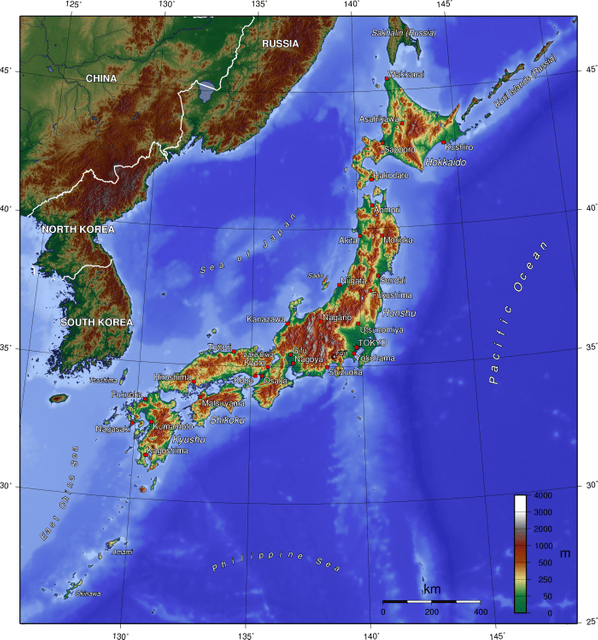
History of Japan
The history of Japan covers Japan and its relation to the world. It is characterized by isolationist, semi-open and expansionist periods.
The very first human habitation in the Japanese archipelago has been traced to prehistoric times around 30,000 BC.[2] The Jōmon period, named after its "cord-marked" pottery, was followed by the Yayoi in the first millennium BC when new technologies were introduced from continental Asia. During this period, the first known written reference to Japan was recorded in the Chinese Book of Han in the first century AD. Between the fourth century and the ninth century, Japan's many kingdoms and tribes gradually came to be unified under a centralized government, nominally controlled by the Emperor. This imperial dynasty continues to reign over Japan. In 794, a new imperial capital was established at Heian-kyō (modern Kyoto), marking the beginning of the Heian period, which lasted until 1185. The Heian period is considered a golden age of classical Japanese culture. Japanese religious life from this time and onwards was a mix of native Shinto practices and Buddhism.
Over the following centuries, the power of the Emperor and the imperial court gradually declined, passing first to great clans of civilian aristocrats – most notably the Fujiwara – and then to the military clans and their armies of samurai. The Minamoto clan under Minamoto no Yoritomo emerged victorious from the Genpei War of 1180–85, defeating their rival military clan, the Taira. After seizing power, Yoritomo set up his capital in Kamakura and took the title of shōgun. In 1274 and 1281, the Kamakura shogunate withstood two Mongol invasions, but in 1333 it was toppled by a rival claimant to the shogunate, ushering in the Muromachi period. During the Muromachi period regional warlords called daimyōs grew in power at the expense of the shōgun. Eventually, Japan descended into a period of civil war. Over the course of the late sixteenth century, Japan was reunified under the leadership of the prominent daimyō Oda Nobunaga and his successor Toyotomi Hideyoshi. After Hideyoshi's death in 1598, Tokugawa Ieyasu came to power and was appointed shōgun by the Emperor. The Tokugawa shogunate, which governed from Edo (modern Tokyo), presided over a prosperous and peaceful era known as the Edo period (1600–1868). The Tokugawa shogunate imposed a strict class system on Japanese society and cut off almost all contact with the outside world.
Portugal and Japan started their first affiliation in 1543, making the Portuguese the first Europeans to reach Japan by landing in the southern archipelago of Japan. They had a significant impact on Japan, even in this initial limited interaction, introducing firearms to Japanese warfare. The Netherlands was the first to establish trade relations with Japan, Japanese and Dutch relations are dating back to 1609. The American Perry Expedition in 1853–54 more completely ended Japan's seclusion; this contributed to the fall of the shogunate and the return of power to the Emperor during the Boshin War in 1868. The new national leadership of the following Meiji period transformed the isolated feudal island country into an empire that closely followed Western models and became a great power. Although democracy developed and modern civilian culture prospered during the Taishō period (1912–26), Japan's powerful military had great autonomy and overruled Japan's civilian leaders in the 1920s and 1930s. The military invaded Manchuria in 1931, and from 1937 the conflict escalated into a prolonged war with China. Japan's attack on Pearl Harbor in December 1941 led to war with the United States and its allies. Japan's forces soon became overextended, but the military held out in spite of Allied air attacks that inflicted severe damage on population centers. Emperor Hirohito announced Japan's unconditional surrender on August 15, 1945, following the atomic bombings of Hiroshima and Nagasaki and the Soviet invasion of Manchuria.
The Allies occupied Japan until 1952, during which a new constitution was enacted in 1947 that transformed Japan into a constitutional monarchy. After 1955, Japan enjoyed very high economic growth, and became a world economic powerhouse. Since the 1990s, the Lost Decade had been a major issue, such as the 1995 Great Kobe-Osaka earthquake and Tokyo subway sarin attack. In 2004, Japan sent a military force as part of the international coalition forces during the Iraq War.
On Friday, March 11, 2011, at 2:46 p.m. (UTC+9), Japan suffered from a powerful magnitude 9.0 earthquake and tsunami, one of the most powerful earthquakes recorded. The earthquake killed almost 20,000 people, affected places in the three regions of Tohoku, Chubu, and Kanto in the northeast of Honshu, including the Tokyo area, had massive economic ramifications, and caused the serious Fukushima nuclear power disaster.
Geographical background
The size of Japan is 377,973.89 km2 (145,936.53 sq mi) in 2018.[4] This makes it 1.56 times bigger than the United Kingdom 242,495 km2 (93,628 sq mi). Japan is the largest island country in East Asia and the fourth largest island country in the world. Japan has the sixth longest coastline (29,751 km (18,486 mi)) and the eighth largest Exclusive Economic Zone of 4,470,000 km2 (1,730,000 sq mi).[5]
The islands of Japan were created by tectonic plate movements over several 100 millions of years from the mid-Silurian (443.8 Mya) to the Pleistocene (11,700 years ago). Japan is located in the northwestern Ring of Fire on multiple tectonic plates.[6] East of the Japanese archipelago are three oceanic trenches. The Japan Trench is created as the oceanic Pacific Plate subducts beneath the continental Okhotsk Plate.[7] The continuous subduction process causes frequent earthquakes, tsunami and stratovolcanoes.[8] The islands are also affected by typhoons. The subduction plates have pulled the Japanese archipelago eastward, created the Sea of Japan and separated it from the Asian continent by back-arc spreading 15 million years ago.[6]
Japan has 108 active volcanoes, making up 10 percent of all active volcanoes in the world. The stratovolcanoes are near the subduction zones of the tectonic plates. During the twentieth century several new volcanoes emerged, including Shōwa-shinzan on Hokkaido and Myōjin-shō off the Bayonnaise Rocks in the Pacific.[8] As many as 1,500 earthquakes are recorded yearly, and magnitudes of 4 to 7 are common.
About 73% of Japan is mountainous, with a mountain range running through each of the main islands. Japan's highest mountain is Mount Fuji, with an elevation of 3,776 m (12,388 ft). Japan's forest cover rate is 68.55% since the mountains are heavily forested. The only other developed nations with such a high forest cover percentage are Finland and Sweden.[9] The population is clustered in urban areas on the coast, plains and valleys.[10] Japan is the 2nd most populous island country with a population of around 126 million,[11] in 2017.
There is a great variety to the geographical features and weather patterns, with a wet season which takes place in early summer for most areas. The Volcanic soil that washes along the 13% of the area that makes up the coastal plains provides fertile land. The mainly temperate climate allows long growing seasons with a diversity of flora and fauna. This provides rich resources to support a high population.[12] The climate of the Japanese archipelago varies from humid continental in the north (Hokkaido) to humid subtropical and tropical rainforest in the south (Okinawa Prefecture).
The remote location makes Japan relatively secure against foreign invasions. The Japanese archipelago is surrounded by vast seas and it has rugged, mountainous terrain with steep rivers. Kyushu is closest to the southernmost point of the Korean peninsula with a distance of 190 km (120 mi). Throughout history, Japan was never fully invaded or conquered by foreigners. The Mongols tried to invade Japan twice and were repelled in 1274 and 1281.
Overview
A commonly accepted periodization of Japanese history:
| Dates | Period | Period | Subperiod | Main government |
|---|---|---|---|---|
| 30,000–10,000 BC | Japanese Paleolithic | unknown | ||
| 14,000–1000 BC | Ancient Japan | Jōmon | ||
| 1000 BC – 300 AD | Yayoi | |||
| 300–538 | Kofun | Imperial government | ||
| 538–710 | Classical Japan | Asuka | ||
| 710–794 | Nara | |||
| 794–1185 | Heian | |||
| 1185–1333 | Medieval Japan | Kamakura | Kamakura shogunate | |
| 1333–1336 | Kenmu Restoration | Imperial government | ||
| 1336–1392 | Muromachi | Nanboku-chō period | Ashikaga shogunate | |
| 1392–1467 | ||||
| 1467–1573 | Sengoku period | Ashikaga shogunate and sengoku daimyōs | ||
| 1573–1603 | Azuchi–Momoyama | Oda Nobunaga, Toyotomi Hideyoshi and Tokugawa Ieyasu | ||
| 1603–1868 | Early Modern Japan | Edo | Tokugawa period | Tokugawa shogunate |
| 1868–1912 | Modern Japan | Meiji | Pre-war | Imperial government |
| 1912–1926 | Taishō | |||
| 1926–1945 | Shōwa (Prewar) | |||
| 1945–1952 | Contemporary Japan | Shōwa (Occupied Post-war) | Post-war | GHQ/SCAP |
| 1952–1989 | Shōwa (Post-occupation) | Parliamentary democracy | ||
| 1989–2019 | Heisei | |||
| 2019–present | Reiwa | |||
Prehistoric and ancient Japan
Paleolithic period

Japan at the Last Glacial Maximum in the Late Pleistocene about 20,000 years ago – regions above sea level (white color) – unvegetated – sea black outline indicates present-day Japan
Land bridges, during glacial periods when the world sea level is lower, have periodically linked the Japanese archipelago to the Asian continent via Sakhalin Island in the north and via the Ryukyu Islands and Taiwan in the south since the beginning of the current Quaternary glaciation 2.58 million years ago. There may also have been a land bridge to Korea in the southwest, though not in the 125,000 years or so since the start of the last interglacial. The Korea Strait was, however, quite narrow at the Last Glacial Maximum from 25,000 to 20,000 years BP. The earliest firm evidence of human habitation is of early Upper Paleolithic hunter-gatherers from 40,000 years ago, when Japan was separated from the continent. Edge-ground axes dating to 32–38,000 years ago found in 224 sites in Honshu and Kyushu are unlike anything found in neighboring areas of continental Asia,[13] and have been proposed as evidence for the first Homo sapiens in Japan; watercraft appear to have been in use in this period.[14] Radiocarbon dating has shown that the earliest fossils in Japan date back to around 32,000–27,000 years ago; for example in the case of Yamashita Cave 32,100 ± 1,000 BP, in Sakitari Cave cal 31,000–29,000 BP,[2] in Shiraho Saonetabaru Cave c. 27,000 BP among others.[15][16][17]
Jōmon period
The Jōmon period of prehistoric Japan spans from about 12,000 BC[18] (in some cases dates as early as 14,500 BC are given[19]) to about 1,000 BC.[20][21][22] Japan was inhabited by a hunter-gatherer culture that reached a considerable degree of sedentism and cultural complexity. The name "cord-marked" was first applied by the American scholar Edward S. Morse who discovered shards of pottery in 1877 and subsequently translated it into Japanese as jōmon.[23] The pottery style characteristic of the first phases of Jōmon culture was decorated by impressing cords into the surface of wet clay. The Jōmon pottery is generally accepted to be among the oldest in East Asia and the world.[24]
Yayoi period
The Yayoi people brought new technologies and modes of living to the Japanese archipelago. It took over from the Jōmon culture and spread from northern Kyushu. Yayoi culture quickly spread to the main island of Honshū, mixing with native Jōmon culture.[25] The date of the change was until recently thought to be around 400 BC,[26][27] but radio-carbon evidence suggests a date up to 500 years earlier, between 1,000 and 800 BC.[28][29] A recent study that used accelerator mass spectrometry to analyze carbonized remains on pottery and wooden stakes, suggests that they dated back to 900–800 BC, 500 years earlier than previously believed.[30]
The period was named after a district in Tokyo where a new, unembellished style of pottery was discovered in 1884. Though hunting and foraging continued, the Yayoi period brought a new reliance on agriculture.[29] Bronze and iron weapons and tools were imported from China and Korea; such tools were later also produced in Japan.[31] The Yayoi period also saw the introduction of weaving and silk production,[32] glassmaking[33] and new techniques of woodworking.[29]
The Yayoi technologies originated on the Asian mainland. There is debate among scholars as to what extent their spread was accomplished by means of migration or simply a diffusion of ideas, or a combination of both. The migration theory is supported by genetic and linguistic studies.[29] Hanihara Kazurō has suggested that the annual immigrant influx from the continent ranged from 350 to 3,000.[34] Modern Japanese are genetically more similar to the Yayoi people than to the Jōmon people—though more so in southern Japan than in the north—whereas the Ainu bear significant resemblance to the Jōmon people.[35] It took time for the Yayoi people and their descendants to displace and intermix with the Jōmon, who continued to exist in northern Honshu until the eighth century AD.[36] A 2017 study on ancient Jōmon aDNA from the Sanganji shell mound in Tōhoku estimated that the modern mainland Japanese inherited <20% of Jōmon peoples' genomes, and their genetic admixture resulted of the indigenous Jōmon people, the Yayoi people and later migrants during and after the Yayoi period.[37] A more recent estimation (2019) suggests about 10% Jōmon ancestry in modern Japanese (Yamato).[38]
The population of Japan began to increase rapidly, perhaps with a 10-fold rise over the Jōmon. Calculations of the population size have varied from 1.5 to 4.5 million by the end of the Yayoi.[39] Skeletal remains from the late Jōmon period reveal a deterioration in already poor standards of health and nutrition, in contrast to Yayoi archaeological sites where there are large structures suggestive of grain storehouses. This change was accompanied by an increase in both the stratification of society and tribal warfare, indicated by segregated gravesites and military fortifications.[29] The Yoshinogari site, a large moated village of the period, began to be excavated by archaeologists in the late-1980s.[40]
During the Yayoi period, the Yayoi tribes gradually coalesced into a number of kingdoms. The earliest written work of history to mention Japan, the Book of Han completed around 82 AD, states that Japan, referred to as Wa, was divided into one hundred kingdoms. A later Chinese work of history, the Wei Zhi, states that by 240 AD, one powerful kingdom had gained ascendancy over the others. According to the Wei Zhi, this kingdom was called Yamatai, though modern historians continue to debate its location and other aspects of its depiction in the Wei Zhi. Yamatai was said to have been ruled by the female monarch Himiko.[41]
Kofun period (c. 250–538)
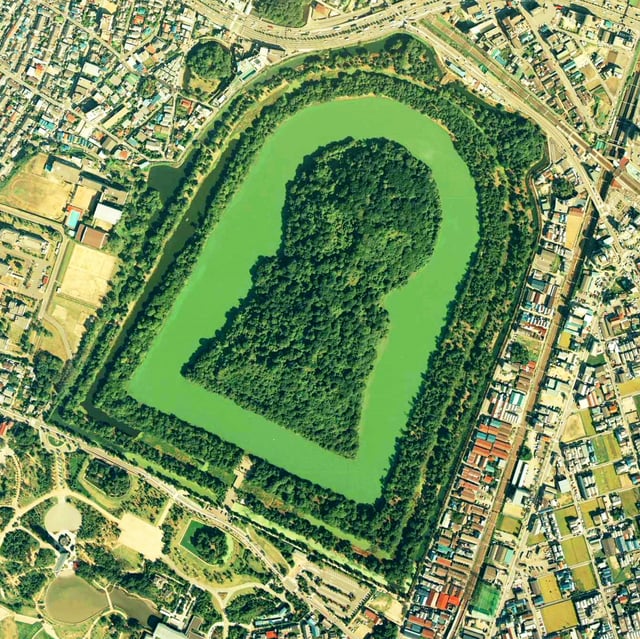
Daisenryō Kofun, Osaka

Territorial extent of Yamato court during the Kofun period
During the subsequent Kofun period, most of Japan gradually unified under a single kingdom. The symbol of the growing power of Japan's new leaders was the kofun burial mounds they constructed from around AD 250 onwards.[42] Many were of massive scales, such as the Daisen Kofun, a 500 m-long keyhole-shaped burial mound that took huge teams of laborers fifteen years to complete.[43] It is commonly accepted that the tomb was built for the late Emperor Nintoku.[44] The kofun were often surrounded by and filled with numerous haniwa clay sculptures, often in the shape of warriors and horses.[42] The Nintoku-tennō-ryō Kofun, is one grave mound which is a 486 metres (1,594 ft) long tumulus enclosed by a moat and a fortification which is 840 metres (2,760 ft) in length; this is regarded as the largest such mound in the world.[45]
The center of the unified state was Yamato in the Kinai region of central Japan.[42] The rulers of the Yamato state were a hereditary line of Emperors who still reign as the world's longest dynasty. The rulers of the Yamato extended their power across Japan through military conquest, but their preferred method of expansion was to convince local leaders to accept their authority in exchange for positions of influence in the government.[46] Many of the powerful local clans who joined the Yamato state became known as the uji.[47]
These leaders sought and received formal diplomatic recognition from China, and Chinese accounts record five successive such leaders as the Five kings of Wa. Craftsmen and scholars from China and the Three Kingdoms of Korea played an important role in transmitting continental technologies and administrative skills to Japan during this period.[47]
Classical Japan
Asuka period (538–710)[1]
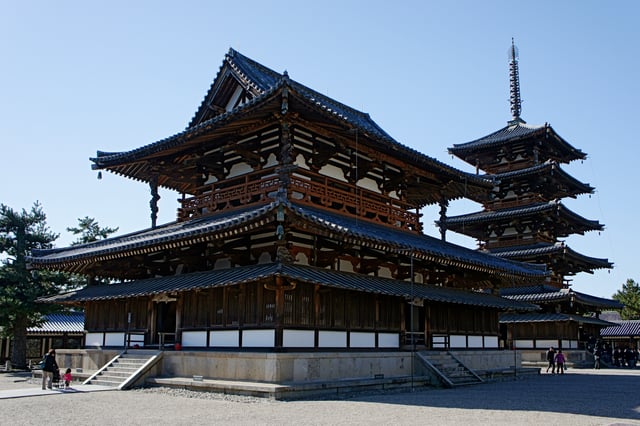
Buddhist temple of Horyu-ji is the oldest wooden structure in the world. It was commissioned by Prince Shotoku and represents the beginning of Buddhism in Japan.
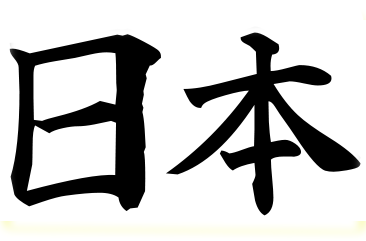
The word Nihon written in kanji (horizontal placement of characters). The text means "Japan" in Japanese.
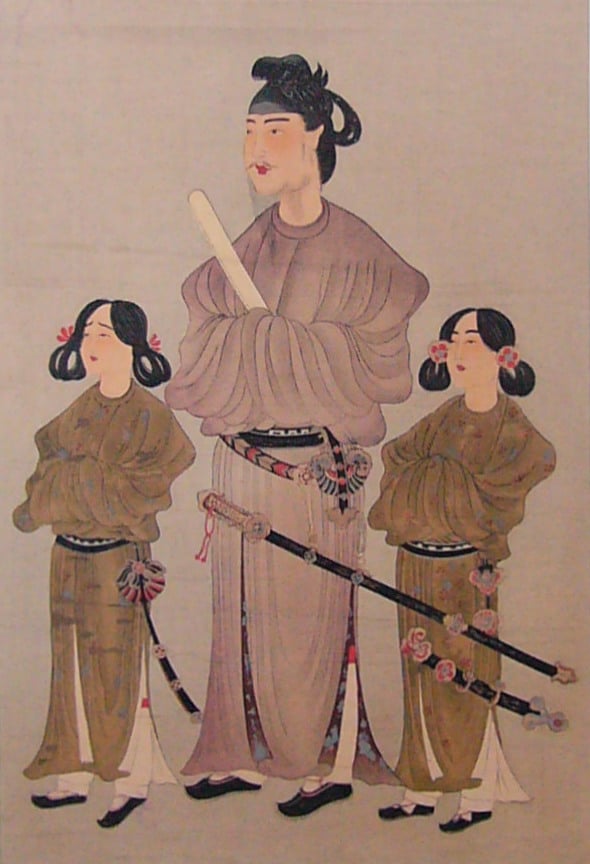
Prince Shōtoku was a semi-legendary regent and a politician of the Asuka period.
The Asuka period began in 538 AD with the introduction of the Buddhist religion from the Korean kingdom of Baekje.[48] Since then, Buddhism has coexisted with Japan's native Shinto religion, in what is today known as Shinbutsu-shūgō.[49] The period draws its name from the de facto imperial capital, Asuka, in the Kinai region.[48]
At the end of the Kofun period and during the Asuka period, Iranian influence reached its maximum. It is suggested that some Scythians and Persians settled in Japan and were granted titles of feudal lords by the emperor. In turn, they had some influence on the aristocratic system and art of Japan. Persia and Japan were connected through the Silk Road and established good diplomatic relations.[50][51][52]
The Buddhist Soga clan took over the government in 587 and controlled Japan from behind the scenes for nearly sixty years.[53] Prince Shōtoku, an advocate of Buddhism and of the Soga cause, who was of partial Soga descent, served as regent and de facto leader of Japan from 594 to 622. Shōtoku authored the Seventeen-article constitution, a Confucian-inspired code of conduct for officials and citizens, and attempted to introduce a merit-based civil service called the Cap and Rank System.[54] In 607, Shōtoku offered a subtle insult to China by opening his letter with the phrase, "The sovereign of the land where the sun rises is sending this mail to the sovereign of the land where the sun sets" as seen in the kanji characters for Japan (Nippon) thus indicating that sun's full strength originates with Japan and China receives the waning sun.[55] By 670 a variant of this expression, Nihon, established itself as the official name of the nation, which has persisted to this day.[56]
In 645, the Soga clan were overthrown in a coup launched by Prince Naka no Ōe and Fujiwara no Kamatari, the founder of the Fujiwara clan.[57] Their government devised and implemented the far-reaching Taika Reforms. The Reform began with land reform, based on Confucian ideas and philosophies from China. It nationalized all land in Japan, to be distributed equally among cultivators, and ordered the compilation of a household registry as the basis for a new system of taxation.[58] The true aim of the reforms was to bring about greater centralization and to enhance the power of the imperial court, which was also based on the governmental structure of China. Envoys and students were dispatched to China to learn seemingly everything from the Chinese writing system, literature, religion, and architecture, to even dietary habits at this time. Even today, the impact of the reforms can still be seen in Japanese cultural life. After the reforms, the Jinshin War of 672, a bloody conflict between Prince Ōama and his nephew Prince Ōtomo, two rivals to the throne, became a major catalyst for further administrative reforms.[57] These reforms culminated with the promulgation of the Taihō Code, which consolidated existing statutes and established the structure of the central government and its subordinate local governments.[59] These legal reforms created the ritsuryō state, a system of Chinese-style centralized government that remained in place for half a millennium.[57]
The art of the Asuka period embodies the themes of Buddhist art. One of the most famous works is the Buddhist temple of Horyu-ji, commissioned by Prince Shōtoku in the early 7th century and completed in 607 AD. It is the oldest wooden structure in the world. This represents the beginning of the presence of Buddhism in Japan.[60]
Nara period (710–794)
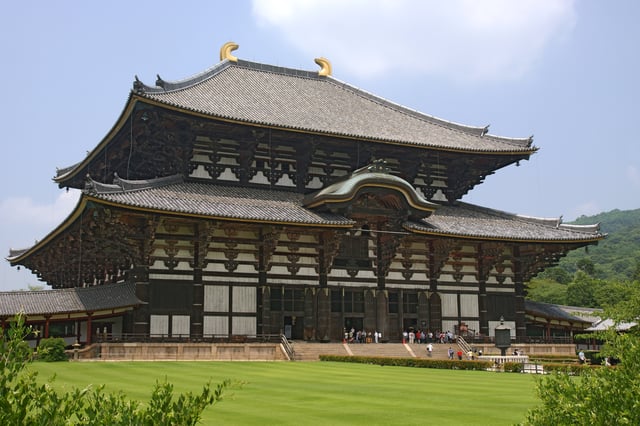
The Daibutsu-den, within the complex of Tōdai-ji. This Buddhist temple was sponsored by the Imperial Court during the Nara period.
In 710, the government constructed a grandiose new capital at Heijō-kyō (modern Nara) modeled on Chang'an, the capital of the Chinese Tang dynasty. During this period, the first two books produced in Japan appeared: the Kojiki and Nihon Shoki,[61] which contain chronicles of legendary accounts of early Japan and its creation myth, which describes the imperial line as descendants of the gods.[62] The latter half of the eighth century saw the compilation of the Man'yōshū, widely considered the finest collection of Japanese poetry.[63]
During this period, Japan suffered a series of natural disasters, including wildfires, droughts, famines, and outbreaks of disease, such as a smallpox epidemic in 735–737 that killed over a quarter of the population.[64] Emperor Shōmu (r. 724–49) feared his lack of piousness had caused the trouble and so increased the government's promotion of Buddhism, including the construction of the temple Tōdai-ji.[65] The funds to build this temple were raised in part by the influential Buddhist monk Gyōki, and once completed it was used by the Chinese monk Ganjin as an ordination site.[66] Japan nevertheless entered a phase of population decline that continued well into the following Heian period.[67]
The Tōdai-ji is a Buddhist temple complex that was sponsored by the Imperial Court. It was once part of the powerful Seven Great Temples, located in the ancient former capital Nara. Todai-ji was opened in the year 752 CE.[68] Its Great Buddha Hall (大仏殿 Daibutsuden) houses the world's largest bronze statue of the Buddha Vairocana, called the Daibutsu (大仏) in Japan.
Heian period (794–1185)

Miniature model of the ancient capital Heian-kyō
In 784, the capital moved briefly to Nagaoka-kyō, then again in 794 to Heian-kyō (modern Kyoto), which remained the capital until 1868.[69] Political power within the court soon passed to the Fujiwara clan, a family of court nobles who grew increasingly close to the imperial family through intermarriage.[70]
Between 812–814 CE, a smallpox epidemic killed almost half of the Japanese population.[71]
In 858, Fujiwara no Yoshifusa had himself declared sesshō ("regent") to the underage Emperor. His son Fujiwara no Mototsune created the office of kampaku, which could rule in the place of an adult reigning Emperor. Fujiwara no Michinaga, an exceptional statesman who became kampaku in 996, governed during the height of the Fujiwara clan's power[72] and married four of his daughters to emperors, current and future.[70] The Fujiwara clan held on to power until 1086, when Emperor Shirakawa ceded the throne to his son Emperor Horikawa but continued to exercise political power, establishing the practice of cloistered rule,[73] by which the reigning Emperor would function as a figurehead while the real authority was held by a retired predecessor behind the scenes.[74]
Throughout the Heian period, the power of the imperial court declined. The court became so self-absorbed with power struggles, and with the artistic pursuits of court nobles, that it neglected the administration of government outside the capital.[70] The nationalization of land undertaken as part of the ritsuryō state decayed as various noble families and religious orders succeeded in securing tax-exempt status for their private shōen manors.[72] By the eleventh century, more land in Japan was controlled by shōen owners than by the central government. The imperial court was thus deprived of the tax revenue to pay for its national army. In response, the owners of the shōen set up their own armies of samurai warriors.[75] Two powerful noble families that had descended from branches of the imperial family,[76] the Taira and Minamoto clans, acquired large armies and many shōen outside the capital. The central government began to use these two warrior clans to suppress rebellions and piracy.[77] Japan's population stabilized during the late-Heian period after hundreds of years of decline.[78]
During the early Heian period, the imperial court successfully consolidated its control over the Emishi people of northern Honshu.[79] Ōtomo no Otomaro was the first man the court granted the title of seii tai-shōgun ("Great Barbarian Subduing General").[80] In 802, seii tai-shōgun Sakanoue no Tamuramaro subjugated the Emishi people, who were led by Aterui.[79] By 1051, members of the Abe clan, who occupied key posts in the regional government, were openly defying the central authority. The court requested the Minamoto clan to engage the Abe clan, whom they defeated in the Former Nine Years War.[81] The court, thus, temporarily reasserted its authority in northern Japan. Following another civil war – the Later Three-Year War – Fujiwara no Kiyohira took full power; his family, the Northern Fujiwara, controlled northern Honshu for the next century from their capital Hiraizumi.[82]
In 1156, a dispute over succession to the throne erupted and the two rival claimants (Emperor Go-Shirakawa and Emperor Sutoku) hired the Taira and Minamoto clans in the hopes of securing the throne by military force. During this war, the Taira clan led by Taira no Kiyomori defeated the Minamoto clan. Kiyomori used his victory to accumulate power for himself in Kyoto and even installed his own grandson Antoku as Emperor. The outcome of this war led to the rivalry between the Minamoto and Taira clans. As a result, the dispute and power struggle between both clans led to the Heiji Rebellion in 1160. In 1180, Taira no Kiyomori was challenged by an uprising led by Minamoto no Yoritomo, a member of the Minamoto clan whom Kiyomori had exiled to Kamakura.[83] Though Taira no Kiyomori died in 1181, the ensuing bloody Genpei War between the Taira and Minamoto families continued for another four years. The victory of the Minamoto clan was sealed in 1185, when a force commanded by Yoritomo's younger brother, Minamoto no Yoshitsune, scored a decisive victory at the naval Battle of Dan-no-ura. Yoritomo and his retainers, thus, became the de facto rulers of Japan.[84]
Heian culture
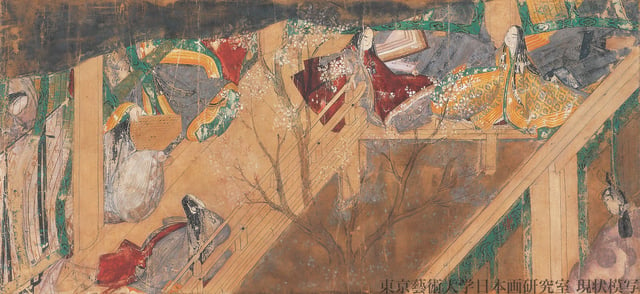
A handscroll painting dated c. 1130, illustrating a scene from the "Bamboo River" chapter of The Tale of Genji
During the Heian period, the imperial court was a vibrant center of high art and culture.[85] Its literary accomplishments include the poetry collection Kokinshū and the Tosa Diary, both associated with the poet Ki no Tsurayuki, as well as Sei Shōnagon's collection of miscellany The Pillow Book,[86] and Murasaki Shikibu's Tale of Genji, often considered the masterpiece of Japanese literature.[87]
The development of the kana written syllabaries was part of a general trend of declining Chinese influence during the Heian period. The official Japanese missions to Tang dynasty of China, which began in the year 630,[88] ended during the ninth century, though informal missions of monks and scholars continued, and thereafter the development of native Japanese forms of art and poetry accelerated.[89] A major architectural achievement, apart from Heian-kyō itself, was the temple of Byōdō-in built in 1053 in Uji.[90] Many other vast temple complexes were also developed and expanded, such as those on Mount Hiei.
Medieval Japan
Kamakura period (1185–1333)
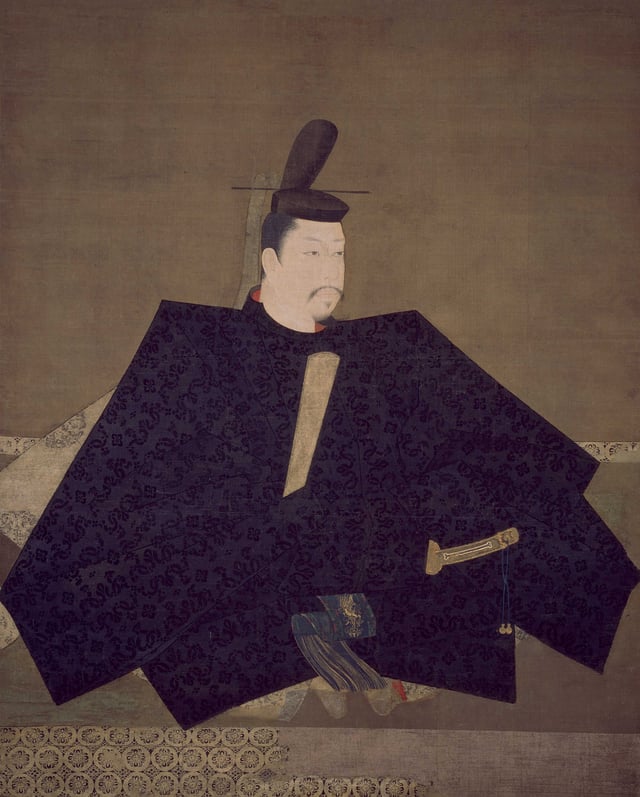
Minamoto no Yoritomo was the founder of the Kamakura shogunate in 1192. This was the first military government in which the shogun with the samurai were the de facto rulers of Japan.
Upon the consolidation of power, Minamoto no Yoritomo chose to rule in concert with the Imperial Court in Kyoto. Though Yoritomo set up his own government in Kamakura in the Kantō region located in eastern Japan, its power was legally authorized by the Imperial court in Kyoto in several occasions. In 1192, the Emperor declared Yoritomo seii tai-shōgun (征夷大将軍; Eastern Barbarian Subduing Great General), abbreviated shōgun.[91] Later (in Edo period), the word bakufu (幕府; originally means a general's house or office, literally a "tent office") came to be used to mean a government headed by a shogun. The English term shogunate refers to the bakufu.[92] Japan remained largely under military rule until 1868.[93]
Legitimacy was conferred on the shogunate by the Imperial court, but the shogunate was the de facto rulers of the country. The court maintained bureaucratic and religious functions, and the shogunate welcomed participation by members of the aristocratic class. The older institutions remained intact in a weakened form, and Kyoto remained the official capital. This system has been contrasted with the "simple warrior rule" of the later Muromachi period.[91]
While the Ise branch of the Taira, which had fought against Yoritomo, was extinguished, other branches, as well as the Hōjō, Chiba, Hatakeyama and other families descended from the Taira, continued to thrive in eastern Japan, with some (notably the Hōjō) attaining high positions in the Kamakura shogunate.[94] Yoshitsune was initially harbored by Fujiwara no Hidehira, the grandson of Kiyohira and the de facto ruler of northern Honshu. In 1189, after Hidehira's death, his successor Yasuhira attempted to curry favor with Yoritomo by attacking Yoshitsune's home. Although Yoshitsune was killed, Yoritomo still invaded and conquered the Northern Fujiwara clan's territories.[95] In subsequent centuries, Yoshitsune would become a legendary figure, portrayed in countless works of literature as an idealized tragic hero.[96]
After Yoritomo's death in 1199, the office of shogun weakened. Behind the scenes, Yoritomo's wife Hōjō Masako became the true power behind the government. In 1203, her father, Hōjō Tokimasa, was appointed regent to the shogun, Yoritomo's son Minamoto no Sanetomo. Henceforth, the Minamoto shoguns became puppets of the Hōjō regents, who wielded actual power.[97]
The regime that Yoritomo had established, and which was kept in place by his successors, was decentralized and feudalistic in structure, in contrast with the earlier ritsuryō state. Yoritomo selected the provincial governors, known under the titles of shugo or jitō,[98] from among his close vassals, the gokenin. The Kamakura shogunate allowed its vassals to maintain their own armies and to administer law and order in their provinces on their own terms.[99]
In 1221, the retired Emperor Go-Toba instigated what became known as the Jōkyū War, a rebellion against the shogunate, in an attempt to restore political power to the court. The rebellion was a failure and led to Go-Toba himself being exiled to Oki Island, along with two other Emperors, the retired Emperor Tsuchimikado and Emperor Juntoku, who were exiled to Tosa Province and Sado Island respectively.[100] The shogunate further consolidated its political power relative to the Kyoto aristocracy.[101]
The samurai armies of the whole nation were mobilized in 1274 and 1281 to confront two full-scale invasions launched by Kublai Khan of the Mongol Empire.[102] Though outnumbered by an enemy equipped with superior weaponry, the Japanese fought the Mongols to a standstill in Kyushu on both occasions until the Mongol fleet was destroyed by typhoons called kamikaze, meaning "divine wind". In spite of the Kamakura shogunate's victory, the defense so depleted its finances that it was unable to provide compensation to its vassals for their role in the victory. This had permanent negative consequences for the shogunate's relations with the samurai class.[103]
Discontent among the samurai proved decisive in ending the Kamakura shogunate. In 1333, Emperor Go-Daigo launched a rebellion in the hope of restoring full power to the imperial court. The shogunate sent General Ashikaga Takauji to quell the revolt, but Takauji and his men instead joined forces with Emperor Go-Daigo and overthrew the Kamakura shogunate.[104]
Japan nevertheless entered a period of prosperity and population growth starting around 1250.[105] In rural areas, the greater use of iron tools and fertilizer, improved irrigation techniques, and double-cropping increased productivity and rural villages grew.[106] Fewer famines and epidemics allowed cities to grow and commerce to boom.[105] Buddhism, which had been largely a religion of the elites, was brought to the masses by prominent monks, such as Hōnen (1133–1212), who established Pure Land Buddhism in Japan, and Nichiren (1222–82), who founded Nichiren Buddhism. Zen Buddhism spread widely among the samurai class.[107]
Literary developments of the late-Heian and Kamakura periods
Waka poetry flourished in the late Heian and early Kamakura periods.
The aristocrat Fujiwara no Shunzei was "the leading poet of [his] day"[108] and on a request from Emperor Go-Shirakawa compiled the Senzai Wakashū the seventh imperial collection.[109] Donald Keene noted that Shunzei was "the most eminent poet since Tsurayuki to have been charged with the compilation of an imperial collection".[110] The anthology, commissioned in 1183 but not completed until 1188, after the defeat of the Taira, contained poems by Taira adherents who had been officially denounced as enemies of the throne, as a gesture to calm the vengeful spirits of the Taira.[111] It also contained poems by thirty-three female poets, the most women recognized by any of the late-Heian imperial collections.[112] Teika, Shunzei's son,[113] would become even more important: his Hyakunin Isshu made him "the arbiter of the poetic tastes of most Japanese even as late as the twentieth century".[114] His later work copying manuscripts were of such importance that Keene noted that "what we know of the literature of Teika's day and earlier is mainly what he thought was worthy of preservation."[115] He also served on the committee that compiled the eighth imperial anthology, the Shin Kokin Wakashū,[116] and along with the itinerant monk Saigyō and Emperor Go-Toba, is considered one of the best poets represented in the collection.[117] More poems by Saigyō were included in the collection than those of any other poet.[118] and centuries later Matsuo Bashō selected him as the representative poet of the waka genre.[119]
The Kamakura period saw an explosion in the popularity of a new genre: the "war tale" (gunki monogatari), whose early representative works include the Hōgen Monogatari, Heiji Monogatari and Heike Monogatari.[126] The latter work, which recounted the rise and fall of the Taira clan, has been described as "the Japanese epic", and the twentieth-century novelist and essayist Kafū Nagai called it "a unique and immortal Japanese épopée."[127] These works were at least partly indebted to earlier Heian works such as the Shōmonki (ja:将門記) and Mutsu Waki (ja:陸奥話記), bare historical chronicles of battles fought against Taira no Masakado and the Earlier Nine Years' War, narrated in a non-literary style of classical Chinese as opposed to the mixed Sino-Japanese vernacular of the later Kamakura works.[128]
Muromachi period (1333–1568)
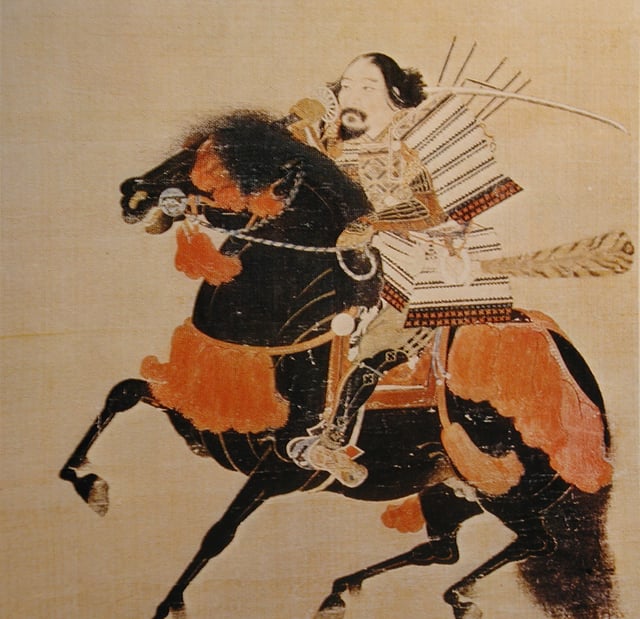
Portrait of Ashikaga Takauji who was the founder and first shōgun of the Ashikaga shogunate
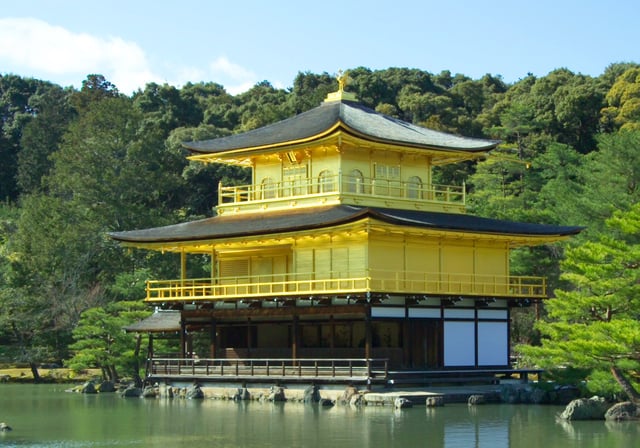
Kinkaku-ji was built in 1397 AD by Ashikaga Yoshimitsu

Map showing the territories of major daimyō families around 1570 CE
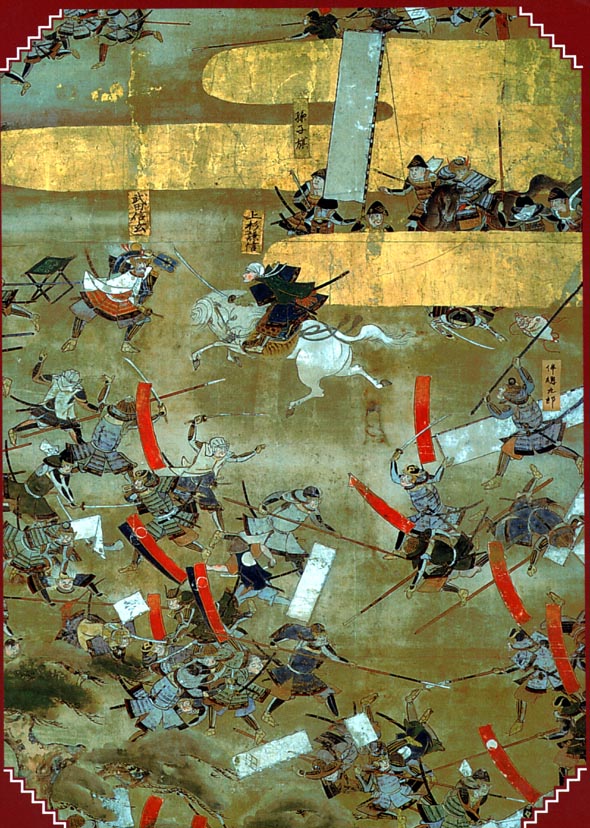
Depiction of the legendary personal conflict between Kenshin and Shingen at the fourth Battle of Kawanakajima (1561)
Takauji and many other samurai soon became dissatisfied with Emperor Go-Daigo's Kenmu Restoration, an ambitious attempt to monopolize power in the imperial court. Takauji rebelled after Go-Daigo refused to appoint him shōgun. In 1338, Takauji captured Kyoto and installed a rival member of the imperial family to the throne, Emperor Kōmyō, who did appoint him shogun.[129] Go-Daigo responded by fleeing to the southern city of Yoshino, where he set up a rival government. This ushered in a prolonged period of conflict between the Northern Court and the Southern Court.[130]
Takauji set up his shogunate in the Muromachi district of Kyoto. However, the shogunate was faced with the twin challenges of fighting the Southern Court and of maintaining its authority over its own subordinate governors.[130] Like the Kamakura shogunate, the Muromachi shogunate appointed its allies to rule in the provinces, but these men increasingly styled themselves as feudal lords—called daimyōs—of their domains and often refused to obey the shogun.[131] The Ashikaga shogun who was most successful at bringing the country together was Takauji's grandson Ashikaga Yoshimitsu, who came to power in 1368 and remained influential until his death in 1408. Yoshimitsu expanded the power of the shogunate and in 1392, brokered a deal to bring the Northern and Southern Courts together and end the civil war. Henceforth, the shogunate kept the Emperor and his court under tight control.[130]
The Kinkaku-ji or "Temple of the Golden Pavilion" was built by the shōgun Ashikaga Yoshimitsu in 1397 CE. The site was originally a villa called Kitayama-dai of the powerful statesman Saionji Kintsune. Ashikaga Yoshimitsu purchased it from the Saionji family and transformed it into Kinkaku-ji.[132] When Yoshimitsu died the building was converted into a Zen temple by his son, according to his wishes.[133][134]
During the final century of the Ashikaga shogunate the country descended into another, more violent period of civil war. This started in 1467 when the Ōnin War broke out over who would succeed the ruling shogun. The daimyōs each took sides and burned Kyoto to the ground while battling for their preferred candidate. By the time the succession was settled in 1477, the shogun had lost all power over the daimyō, who now ruled hundreds of independent states throughout Japan.[135] During this Warring States period, daimyōs fought among themselves for control of the country.[136] Some of the most powerful daimyōs of the era were Uesugi Kenshin, Takeda Shingen,[137] and Date Masamune.[138] One enduring symbol of this era was the ninja, skilled spies and assassins hired by daimyōs. Few definite historical facts are known about the secretive lifestyles of the ninja, who became the subject of many legends.[139] In addition to the daimyōs, rebellious peasants and "warrior monks" affiliated with Buddhist temples also raised their own armies.[140]
Amid this on-going anarchy, a Chinese ship was blown off course and landed in 1543 on the Japanese island of Tanegashima, just south of Kyushu. The three Portuguese traders on board were António Mota, Francisco Zeimoto, and presumably Fernão Mendes Pinto. They were the first Europeans to set foot in Japan.[141] Soon European traders would introduce many new items to Japan, most importantly the musket.[142] By 1556, the daimyōs were already using about 300,000 muskets in their armies.[143] The Europeans also brought Christianity, which soon came to have a substantial following in Japan. The Jesuit missionary Francis Xavier disembarked in Kyushu in 1549.[141]
Muromachi culture
In spite of the war, Japan's relative economic prosperity, which had begun in the Kamakura period, continued well into the Muromachi period. By 1450 Japan's population stood at ten million, compared to six million at the end of the thirteenth century.[105] Commerce flourished, including considerable trade with China and Korea.[144] Because the daimyōs and other groups within Japan were minting their own coins, Japan began to transition from a barter-based to a currency-based economy.[145] During the period, some of Japan's most representative art forms developed, including ink wash painting, ikebana flower arrangement, the tea ceremony, Japanese gardening, bonsai, and Noh theater.[146] Though the eighth Ashikaga shogun, Yoshimasa, was an ineffectual political and military leader, he played a critical role in promoting these cultural developments.[147]
Azuchi–Momoyama period (1568–1600)
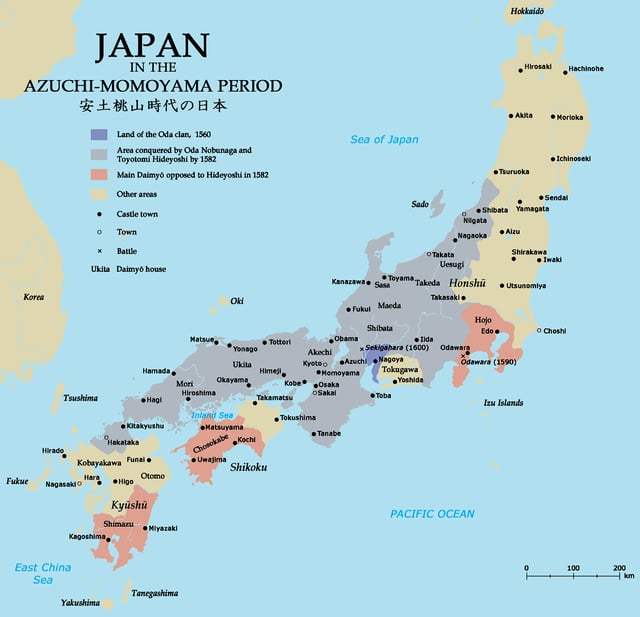
Japan in 1582, showing territory conquered by Oda Nobunaga in gray
During the second half of the 16th century, Japan gradually reunified under two powerful warlords: Oda Nobunaga; and Toyotomi Hideyoshi. The period takes its name from Nobunaga's headquarters, Azuchi Castle, and Hideyoshi's headquarters, Momoyama Castle.[148]
Nobunaga was the daimyō of the small province of Owari. He burst onto the scene suddenly, in 1560, when, during the Battle of Okehazama, his army defeated a force several times its size led by the powerful daimyō Imagawa Yoshimoto.[149] Nobunaga was renowned for his strategic leadership and his ruthlessness. He encouraged Christianity to incite hatred toward his Buddhist enemies and to forge strong relationships with European arms merchants. He equipped his armies with muskets and trained them with innovative tactics.[150] He promoted talented men regardless of their social status, including his peasant servant Toyotomi Hideyoshi, who became one of his best generals.[151]
The Azuchi–Momoyama period began in 1568, when Nobunaga seized Kyoto and thus effectively brought an end to the Ashikaga shogunate.[149] He was well on his way towards his goal of reuniting all Japan in 1582 when one of his own officers, Akechi Mitsuhide, killed him during an abrupt attack on his encampment. Hideyoshi avenged Nobunaga by crushing Akechi's uprising and emerged as Nobunaga's successor.[152] Hideyoshi completed the reunification of Japan by conquering Shikoku, Kyushu, and the lands of the Hōjō family in eastern Japan.[153] He launched sweeping changes to Japanese society, including the confiscation of swords from the peasantry, new restrictions on daimyōs, persecutions of Christians, a thorough land survey, and a new law effectively forbidding the peasants and samurai from changing their social class.[154] Hideyoshi's land survey designated all those who were cultivating the land as being "commoners", an act which effectively granted freedom to most of Japan's slaves.[155]
As Hideyoshi's power expanded he dreamed of conquering China and launched two massive invasions of Korea starting in 1592. Hideyoshi failed to defeat the Chinese and Korean armies on the Korean Peninsula and the war ended only after his death in 1598.
In the hope of founding a new dynasty, Hideyoshi had asked his most trusted subordinates to pledge loyalty to his infant son Toyotomi Hideyori. Despite this, almost immediately after Hideyoshi's death, war broke out between Hideyori's allies and those loyal to Tokugawa Ieyasu, a daimyō and a former ally of Hideyoshi.[156] Tokugawa Ieyasu won a decisive victory at the Battle of Sekigahara in 1600, ushering in 268 uninterrupted years of rule by the Tokugawa clan.[157]
Early modern Japan
Edo period (1600–1868)
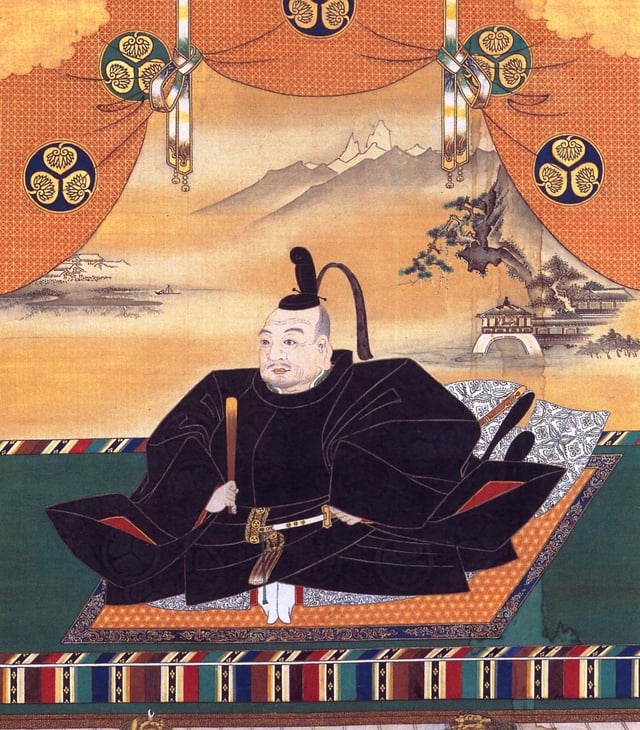
Tokugawa Ieyasu was the founder and first shōgun of the Tokugawa shogunate.
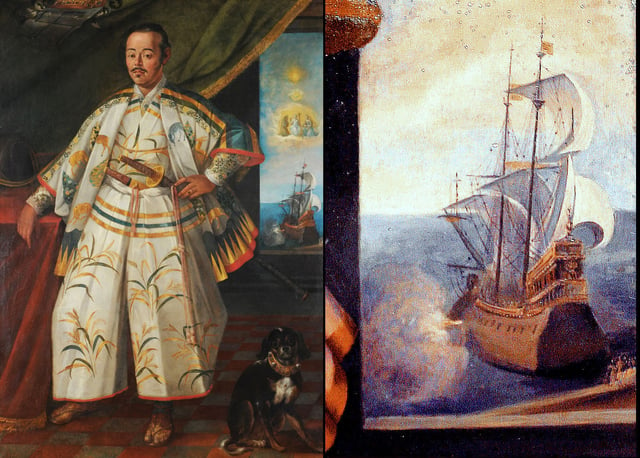
The San Juan Bautista is represented in Claude Deruet's painting of Hasekura Tsunenaga in Rome in 1617, as a galleon with Hasekura's flag (red manji on orange background) on the top mast.
The Edo period was characterized by relative peace and stability[158] under the tight control of the Tokugawa shogunate, which ruled from the eastern city of Edo (modern Tokyo).[159] In 1603, Emperor Go-Yōzei declared Tokugawa Ieyasu shōgun, and Ieyasu abdicated two years later to groom his son as the second shōgun of what became a long dynasty.[160] Nevertheless, it took time for the Tokugawas to consolidate their rule. In 1609, the shōgun gave the daimyō of Satsuma Domain permission to invade the Ryukyu Kingdom for perceived insults towards the shogunate; the Satsuma victory began 266 years of Ryukyu's dual subordination to Satsuma and China.[161][162] Ieyasu led the Siege of Osaka that ended with the destruction of the Toyotomi clan in 1615.[163] Soon after the shogunate promulgated the Laws for the Military Houses, which imposed tighter controls on the daimyōs,[164] and the alternate attendance system, which required each daimyō to spend every other year in Edo.[165] Even so, the daimyōs continued to maintain a significant degree of autonomy in their domains.[166] The central government of the shogunate in Edo, which quickly became the most populous city in the world,[159] took counsel from a group of senior advisors known as rōjū and employed samurai as bureaucrats.[167] The Emperor in Kyoto was funded lavishly by the government but was allowed no political power.[168]
The Tokugawa shogunate went to great lengths to suppress social unrest. Harsh penalties, including crucifixion, beheading, and death by boiling, were decreed for even the most minor offenses, though criminals of high social class were often given the option of seppuku ("self-disembowelment"), an ancient form of suicide that now became ritualized.[165] Christianity, which was seen as a potential threat, was gradually clamped down on until finally, after the Christian-led Shimabara Rebellion of 1638, the religion was completely outlawed.[169] To prevent further foreign ideas from sowing dissent, the third Tokugawa shogun, Iemitsu, implemented the sakoku ("closed country") isolationist policy under which Japanese people were not allowed to travel abroad, return from overseas, or build ocean-going vessels.[170] The only Europeans allowed on Japanese soil were the Dutch, who were granted a single trading post on the island of Dejima. China and Korea were the only other countries permitted to trade,[171] and many foreign books were banned from import.[166]
During the first century of Tokugawa rule, Japan's population doubled to thirty million, due in large part to agricultural growth; the population remained stable for the rest of the period.[172] The shogunate's construction of roads, elimination of road and bridge tolls, and standardization of coinage promoted commercial expansion that also benefited the merchants and artisans of the cities.[173] City populations grew,[174] but almost ninety percent of the population continued to live in rural areas.[175] Both the inhabitants of cities and of rural communities would benefit from one of the most notable social changes of the Edo period: increased literacy and numeracy. The number of private schools greatly expanded, particularly those attached to temples and shrines, and raised literacy to thirty percent. This may have been the world's highest rate at the time[176] and drove a flourishing commercial publishing industry, which grew to produce hundreds of titles per year.[177] In the area of numeracy – approximated by an index measuring people's ability to report an exact rather than a rounded age (age-heaping method), and which level shows a strong correlation to later economic development of a country – Japan's level was comparable to that of north-west European countries, and moreover, Japan's index came close to the 100 percent mark throughout the nineteenth century. These high levels of both literacy and numeracy were part of the socio-economical foundation for Japan's strong growth rates during the following century.[178]
Culture and philosophy
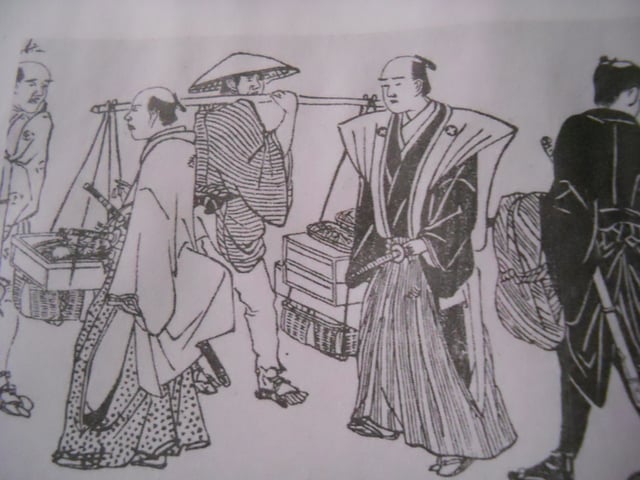
Samurais could kill a commoner for the slightest insult and were widely feared by the Japanese population. Edo period, 1798.
The Edo period was a time of prolific cultural output. Haiku, whose greatest master is generally considered Matsuo Bashō (1644–94),[179] rose as a major form of poetry. Forms of theater developed, such as the flamboyant kabuki drama and bunraku puppet theater, the latter of which reached its height of through the plays of Chikamatsu Monzaemon (1653–1725).[180] Members of the wealthy merchant class who patronized this poetry and theater were said to live hedonistic lives, which came to be called ukiyo ("floating world").[181] They often paid for the services of courtesans and geisha entertainers, most of whom also served as prostitutes in designated red-light districts such as Yoshiwara in Edo.[182] This lifestyle inspired ukiyo-zōshi popular novels and ukiyo-e art, the latter of which were often woodblock prints[183] that progressed to greater sophistication and use of multiple printed colors.[184]
Decline and fall of the shogunate
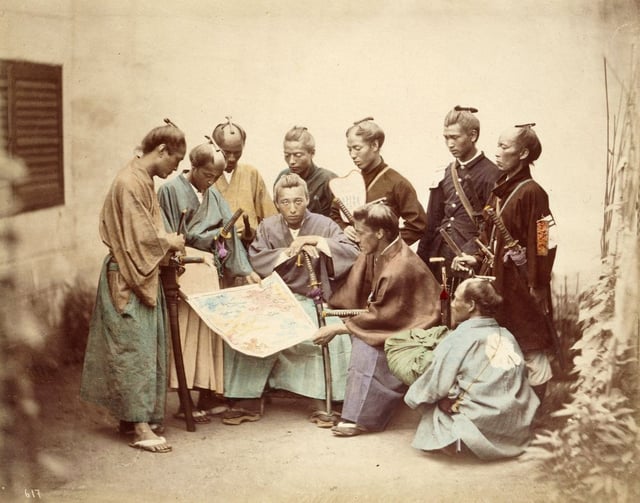
Samurai of the Satsuma Domain during the Boshin War
By the late eighteenth and early nineteenth centuries, the shogunate showed signs of weakening.[185] The dramatic growth of agriculture that had characterized the early Edo period had ended[172] and the government handled the devastating Tenpō famines poorly.[185] Peasant unrest grew and government revenues fell.[186] The shogunate cut the pay of the already financially distressed samurai, many of whom worked side jobs to make a living.[187] Discontented samurai were soon to play a major role in engineering the downfall of the Tokugawa shogunate.[188]
At the same time, the people drew inspiration from new ideas and fields of study. Dutch books brought into Japan stimulated interest in Western learning, called rangaku or "Dutch learning".[189] The physician Sugita Genpaku, for instance, used concepts from Western medicine to help spark a revolution in Japanese ideas of human anatomy.[190] The scholarly field of kokugaku or "National Learning", developed by scholars such as Motoori Norinaga and Hirata Atsutane, promoted what it asserted were native Japanese values. For instance, it criticized the Chinese-style Neo-Confucianism advocated by the shogunate and emphasized the Emperor's divine authority, which the Shinto faith taught had its roots in Japan's mythic past, which was referred to as the "Age of the Gods".[191]
The arrival in 1853 of a fleet of American ships commanded by Commodore Matthew C. Perry threw Japan into turmoil. The US government aimed to end Japan's isolationist policies. The shogunate had no defense against Perry's gunboats and had to agree to his demands that American ships be permitted to acquire provisions and trade at Japanese ports.[185] The US, Great Britain, Russia, and other Western powers imposed what became known as "unequal treaties" on Japan which stipulated that Japan must allow citizens of these countries to visit or reside on Japanese territory and must not levy tariffs on their imports or try them in Japanese courts.[192]
The shogunate's failure to oppose the Western powers angered many Japanese, particularly those of the southern domains of Chōshū and Satsuma.[193] Many samurai there, inspired by the nationalist doctrines of the kokugaku school, adopted the slogan of sonnō jōi ("revere the Emperor, expel the barbarians").[194] The two domains then went on to form an alliance. In August 1866, soon after becoming shogun, Tokugawa Yoshinobu, struggled to maintain power as civil unrest continued.[195] In November 1867, Yoshinobu officially tendered his resignation to the Emperor and he formally stepped down ten days later.[196] The Chōshū and Satsuma domains in 1868 convinced the young Emperor Meiji and his advisors to issue a rescript calling for an end to the Tokugawa shogunate. The armies of Chōshū and Satsuma soon marched on Edo and the ensuing Boshin War led to the eventual fall of the shogunate.[197]
Modern Japan
Meiji period (1868–1912)
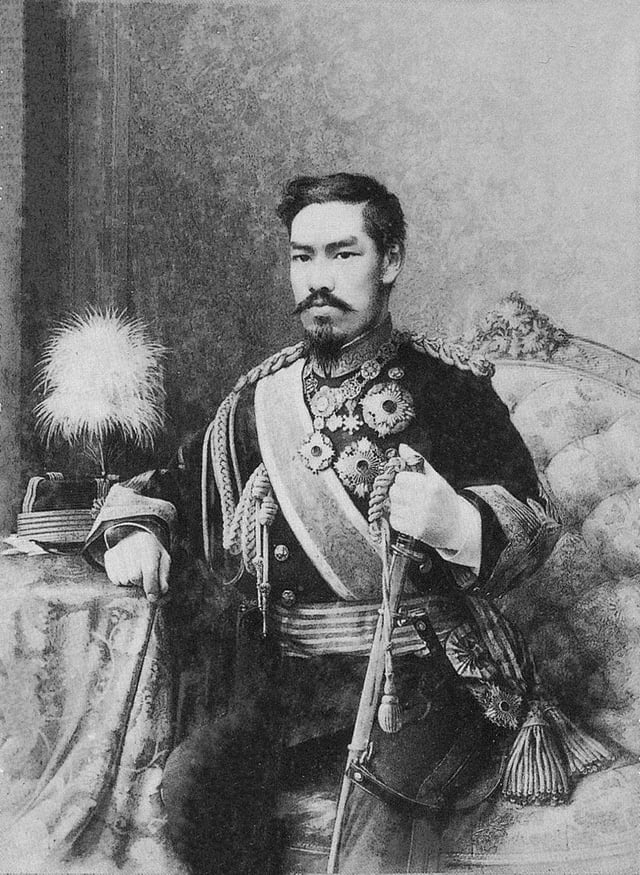
Emperor Meiji, the 122nd Emperor of Japan
The Emperor was restored to nominal supreme power,[198] and in 1869, the imperial family moved to Edo, which was renamed Tokyo ("eastern capital").[199] However, the most powerful men in the government were former samurai from Chōshū and Satsuma rather than the Emperor, who was fifteen in 1868.[198] These men, known as the Meiji oligarchs, oversaw the dramatic changes Japan would experience during this period.[200] The leaders of the Meiji government, who are regarded as some of the most successful statesmen in human history,[201] desired Japan to become a modern nation-state that could stand equal to the Western imperialist powers.[202] Among them were Ōkubo Toshimichi and Saigō Takamori from Satsuma, as well as Kido Takayoshi, Ito Hirobumi, and Yamagata Aritomo from Chōshū.[198]
Political and social changes
The Meiji government abolished the Neo-Confucian class structure[203] and replaced the feudal domains of the daimyōs with prefectures.[199] It instituted comprehensive tax reform[203] and lifted the ban on Christianity. Major government priorities included the introduction of railways,[204] telegraph lines, and a universal education system.
The Meiji government promoted widespread Westernization[205] and hired hundreds of advisers from Western nations with expertise in such fields as education, mining, banking, law, military affairs, and transportation to remodel Japan's institutions.[206] The Japanese adopted the Gregorian calendar, Western clothing, and Western hairstyles.[207] One leading advocate of Westernization was the popular writer Fukuzawa Yukichi.[208] As part of its Westernization drive, the Meiji government enthusiastically sponsored the importation of Western science, above all medical science. In 1893, Kitasato Shibasaburō established the Institute for Infectious Diseases, which would soon become world-famous,[209] and in 1913, Hideyo Noguchi proved the link between syphilis and paresis.[210] Furthermore, the introduction of European literary styles to Japan sparked a boom in new works of prose fiction. Characteristic authors of the period included Futabatei Shimei and Mori Ōgai,[211] although the most famous of the Meiji era writers was Natsume Sōseki,[212] who wrote satirical, autobiographical, and psychological novels[213] combining both the older and newer styles.[214] Ichiyō Higuchi, a leading female author, took inspiration from earlier literary models of the Edo period.[215]
Government institutions developed rapidly in response to the Freedom and People's Rights Movement, a grassroots campaign demanding greater popular participation in politics. The leaders of this movement included Itagaki Taisuke and Ōkuma Shigenobu.[216] Itō Hirobumi, the first Prime Minister of Japan, responded by writing the Meiji Constitution, which was promulgated in 1889. The new constitution established an elected lower house, the House of Representatives, but its powers were restricted. Only two percent of the population were eligible to vote, and legislation proposed in the House required the support of the unelected upper house, the House of Peers. Both the cabinet of Japan and the Japanese military were directly responsible not to the elected legislature but to the Emperor. Concurrently, the Japanese government also developed a form of Japanese nationalism under which Shinto became the state religion and the Emperor was declared a living god.[217] Schools nationwide instilled patriotic values and loyalty to the Emperor.[218]
Rise of imperialism and the military

The Japanese Empire in 1939
In December 1871, a Ryukyuan ship was shipwrecked on Taiwan and the crew were massacred. In 1874, using the incident as a pretext, Japan launched a military expedition to Taiwan to assert their claims to the Ryukyu Islands. The expedition featured the first instance of the Japanese military ignoring the orders of the civilian government, as the expedition set sail after being ordered to postpone.[219]
Yamagata Aritomo, who was born a samurai in the Chōshū Domain, was a key force behind the modernization and enlargement of the Imperial Japanese Army, especially the introduction of national conscription.[220] The new army was put to use in 1877 to crush the Satsuma Rebellion of discontented samurai in southern Japan led by the former Meiji leader Saigo Takamori.[221]
The Japanese military played a key role in Japan's expansion abroad. The government believed that Japan had to acquire its own colonies to compete with the Western colonial powers. After consolidating its control over Hokkaido and annexing the Ryukyu Kingdom, it next turned its attention to China and Korea.[222] In 1894, Japanese and Chinese troops clashed in Korea, where they were both stationed to suppress the Donghak Rebellion. During the ensuing First Sino-Japanese War, Japan's highly motivated and well-led forces defeated the more numerous and better-equipped military of Qing China.[223] The island of Taiwan was thus ceded to Japan in 1895,[224] and Japan's government gained enough international prestige to allow Foreign Minister Mutsu Munemitsu to renegotiate the "unequal treaties".[225] In 1902 Japan signed an important military alliance with the British.[226]
Japan next clashed with Russia, which was expanding its power in Asia. The Russo-Japanese War of 1904–05 ended with the dramatic Battle of Tsushima, which was another victory for Japan's military. Japan thus laid claim to Korea as a protectorate in 1905, followed by full annexation in 1910.[227]
Economic modernization and labor unrest
During the Meiji period, Japan underwent a rapid transition towards an industrial economy.[228] Both the Japanese government and private entrepreneurs adopted Western technology and knowledge to create factories capable of producing a wide range of goods.[229] By the end of the period, the majority of Japan's exports were manufactured goods.[228] Some of Japan's most successful new businesses and industries constituted huge family-owned conglomerates called zaibatsu, such as Mitsubishi and Sumitomo.[230] The phenomenal industrial growth sparked rapid urbanization. The proportion of the population working in agriculture shrank from 75 percent in 1872 to 50 percent by 1920.[231]
Japan enjoyed solid economic growth at this time and most people lived longer and healthier lives. The population rose from 34 million in 1872 to 52 million in 1915.[232] Poor working conditions in factories led to growing labor unrest,[233] and many workers and intellectuals came to embrace socialist ideas.[234] The Meiji government responded with harsh suppression of dissent. Radical socialists plotted to assassinate the Emperor in the High Treason Incident of 1910, after which the Tokkō secret police force was established to root out left-wing agitators.[235] The government also introduced social legislation in 1911 setting maximum work hours and a minimum age for employment.[236]
Communications became a high priority for businesses, government agencies and upscale consumers. They quickly adopted the telegraph. the telephone, phonograph, and radio.[237]
Taishō period (1912–1926)
During the short reign of Emperor Taishō, Japan developed stronger democratic institutions and grew in international power. The Taishō political crisis opened the period with mass protests and riots organized by Japanese political parties, which succeeded in forcing Katsura Tarō to resign as prime minister.[238] This and the rice riots of 1918 increased the power of Japan's political parties over the ruling oligarchy.[239] The Seiyūkai and Minseitō parties came to dominate politics by the end of the so-called "Taishō democracy" era.[240] The franchise for the House of Representatives had been gradually expanded since 1890,[241] and in 1925 universal male suffrage was introduced. However, in the same year the far-reaching Peace Preservation Law also passed, prescribing harsh penalties for political dissidents.[242]
Japan's participation in World War I on the side of the Allies sparked unprecedented economic growth and earned Japan new colonies in the South Pacific seized from Germany.[243] After the war Japan signed the Treaty of Versailles and enjoyed good international relations through its membership in the League of Nations and participation in international disarmament conferences.[244] The Great Kantō earthquake in September 1923 left over 100,000 dead, and combined with the resultant fires destroyed the homes of more than three million.[245]
The growth of popular prose fiction, which began during the Meiji period, continued into the Taishō period as literacy rates rose and book prices dropped.[246] Notable literary figures of the era included short story writer Ryūnosuke Akutagawa[247] and the novelist Haruo Satō. Jun'ichirō Tanizaki, described as "perhaps the most versatile literary figure of his day" by the historian Conrad Totman, produced many works during the Taishō period influenced by European literature, though his 1929 novel Some Prefer Nettles reflects deep appreciation for the virtues of traditional Japanese culture.[248] At the end of the Taishō period, Tarō Hirai, known by his penname Edogawa Ranpo, began writing popular mystery and crime stories.[249]
Shōwa period (1926–1989)
Emperor Hirohito's sixty-three-year reign from 1926 to 1989 is the longest in recorded Japanese history.[250] The first twenty years were characterized by the rise of extreme nationalism and a series of expansionist wars. After suffering defeat in World War II, Japan was occupied by foreign powers for the first time in its history, and then re-emerged as a major world economic power.
Manchurian Incident and the Second Sino-Japanese War

The Empire of Japan in 1937
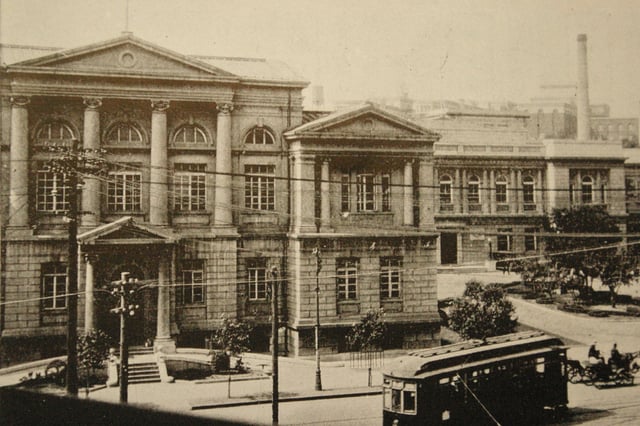
Headquarters of South Manchuria Railway, Dalian, c. 1940

Japanese experts inspect the scene of the 'railway sabotage' on South Manchurian Railway, leading to the Mukden Incident and the Japanese occupation of Manchuria.
Left-wing groups had been subject to violent suppression by the end of the Taishō period,[251] and radical right-wing groups, inspired by fascism and Japanese nationalism, rapidly grew in popularity.[252] The extreme right became influential throughout the Japanese government and society, notably within the Kwantung Army, a Japanese army stationed in China along the Japanese-owned South Manchuria Railroad.[253] During the Manchurian Incident of 1931, radical army officers bombed a small portion of the South Manchuria Railroad and, falsely attributing the attack to the Chinese, invaded Manchuria. The Kwantung Army conquered Manchuria and set up the puppet government of Manchukuo there without permission from the Japanese government. International criticism of Japan following the invasion led to Japan withdrawing from the League of Nations.[254]
Prime Minister Tsuyoshi Inukai of the Seiyūkai Party attempted to restrain the Kwantung Army and was assassinated in 1932 by right-wing extremists. Because of growing opposition within the Japanese military and the extreme right to party politicians, who they saw as corrupt and self-serving, Inukai was the last party politician to govern Japan in the pre-World War II era.[254] In February 1936 young radical officers of the Imperial Japanese Army attempted a coup d'état. They assassinated many moderate politicians before the coup was suppressed.[255] In its wake the Japanese military consolidated its control over the political system and most political parties were abolished when the Imperial Rule Assistance Association was founded in 1940.[256]
Japan's expansionist vision grew increasingly bold. Many of Japan's political elite aspired to have Japan acquire new territory for resource extraction and settlement of surplus population.[257] These ambitions led to the outbreak of the Second Sino-Japanese War in 1937. After their victory in the Chinese capital, the Japanese military committed the infamous Nanjing Massacre. The Japanese military failed to defeat the Chinese government led by Chiang Kai-shek and the war descended into a bloody stalemate that lasted until 1945.[258] Japan's stated war aim was to establish the Greater East Asia Co-Prosperity Sphere, a vast pan-Asian union under Japanese domination.[259] Hirohito's role in Japan's foreign wars remains a subject of controversy, with various historians portraying him as either a powerless figurehead or an enabler and supporter of Japanese militarism.[260]
The United States opposed Japan's invasion of China and responded with increasingly stringent economic sanctions intended to deprive Japan of the resources to continue its war in China.[261] Japan reacted by forging an alliance with Germany and Italy in 1940, known as the Tripartite Pact, which worsened its relations with the US. In July 1941, the United States, the United Kingdom, and the Netherlands froze all Japanese assets when Japan completed its invasion of French Indochina by occupying the southern half of the country, further increasing tension in the Pacific.[262]
World War II
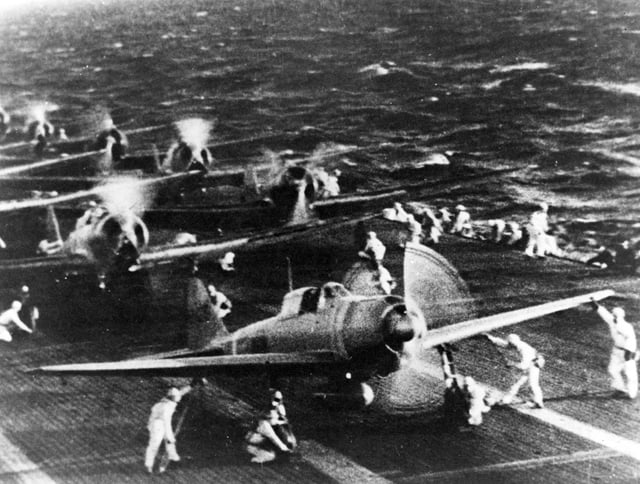
Planes from the Japanese aircraft carrier Shōkaku preparing the attack on Pearl Harbor

The Empire of Japan at its peak in 1942: Territory (1870–1895) Acquisitions (1895–1930) Acquisitions (1930–1942)
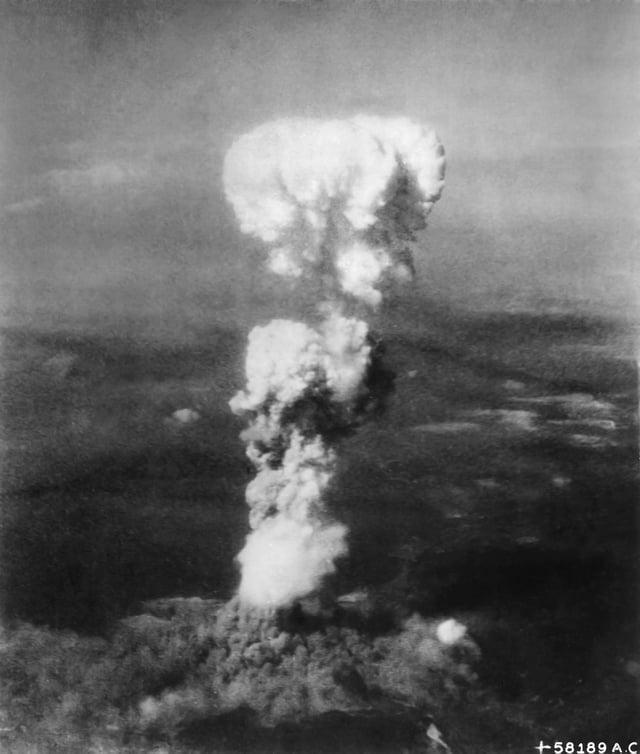
Atomic cloud over Hiroshima, 1945
In late 1941, Japan's government, led by Prime Minister and General Hideki Tojo, decided to break the US-led embargo through force of arms.[263] On December 7, 1941, the Imperial Japanese Navy launched a surprise attack on the American fleet at Pearl Harbor, Hawaii. This brought the US into World War II on the side of the Allies. Japan then successfully invaded the Asian colonies of the United States, the United Kingdom, and the Netherlands, including the Philippines, Malaya, Hong Kong, Singapore, Burma, and the Dutch East Indies.[264]
In the early stages of the war, Japan scored victory after victory. The tide began to turn against Japan following the Battle of Midway in June 1942 and the subsequent Battle of Guadalcanal, in which Allied troops wrested the Solomon Islands from Japanese control.[265] During this period the Japanese military was responsible for such war crimes as mistreatment of prisoners of war, massacres of civilians, and the use of chemical and biological weapons.[266] The Japanese military earned a reputation for fanaticism, often employing banzai charges and fighting almost to the last man against overwhelming odds.[267] In 1944 the Imperial Japanese Navy began deploying squadrons of kamikaze pilots who crashed their planes into enemy ships.[268]
Life in Japan became increasingly difficult for civilians due to stringent rationing of food, electrical outages, and a brutal crackdown on dissent.[269] In 1944 the US Army captured the island of Saipan, which allowed the United States to begin widespread bombing raids on the Japanese mainland.[270] These destroyed over half of the total area of Japan's major cities.[271] The Battle of Okinawa, fought between April and June 1945, was the largest naval operation of the war and left 77,166 Japanese soldiers and more than 140,000 Okinawan civilians dead, suggesting that the planned invasion of mainland Japan would be even bloodier.[272][273] The Japanese superbattleship Yamato was sunk en route to aid in the Battle of Okinawa.[274]
However, on August 6, 1945, the US dropped an atomic bomb over Hiroshima, killing over 70,000 people. This was the first nuclear attack in history. On August 9 the Soviet Union declared war on Japan and invaded Manchukuo and other territories, and Nagasaki was struck by a second atomic bomb, killing around 40,000 people.[275] The unconditional surrender of Japan was announced by Emperor Hirohito and communicated to the Allies on August 14, and broadcast on national radio on the following day, marking the end of Imperial Japan's ultranationalist ideology, and was a major turning point in Japanese history.[276]
Occupation of Japan
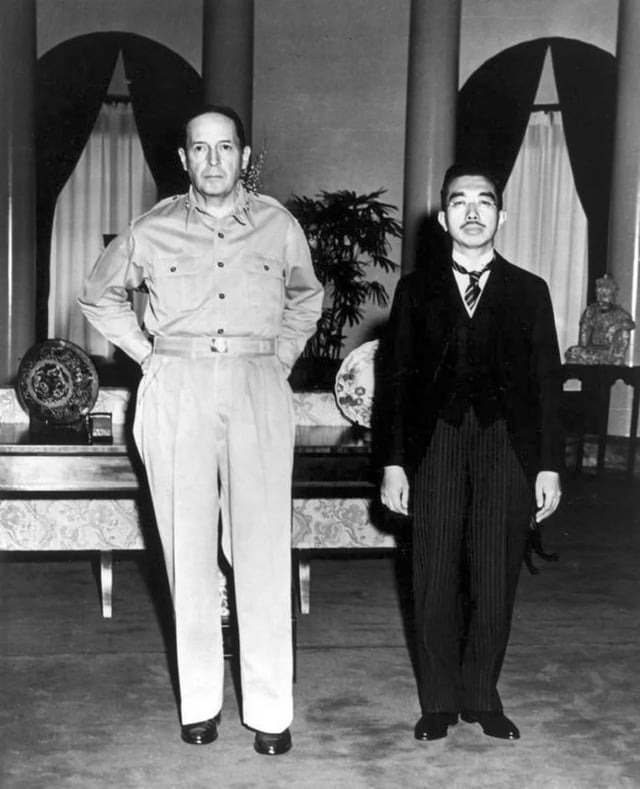
General Douglas MacArthur and Emperor of Japan, Hirohito, at their first meeting, September 1945
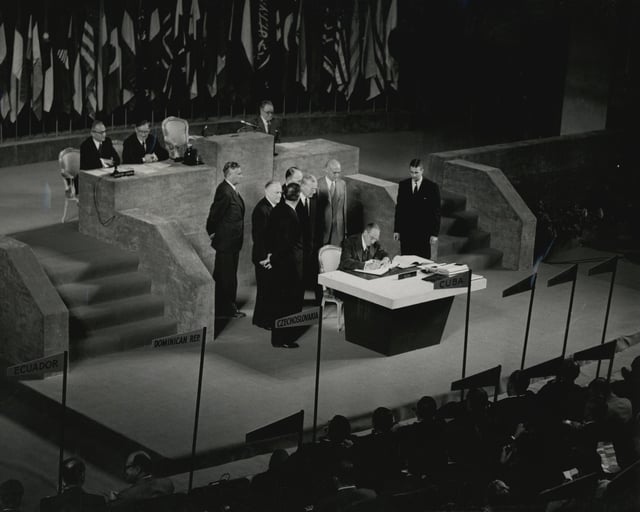
US Secretary of State Dean Acheson signing the Treaty of Peace with Japan, September 8, 1951
Japan experienced dramatic political and social transformation under the Allied occupation in 1945–1952. US General Douglas MacArthur, the Supreme Commander of Allied Powers, served as Japan's de facto leader and played a central role in implementing reforms, many inspired by the New Deal of the 1930s.[277]
The occupation sought to decentralize power in Japan by breaking up the zaibatsu, transferring ownership of agricultural land from landlords to tenant farmers,[278] and promoting labor unionism.[279] Other major goals were the demilitarization and democratization of Japan's government and society. Japan's military was disarmed,[280] its colonies were granted independence,[281] the Peace Preservation Law and Tokkō were abolished,[282] and the International Military Tribunal of the Far East tried war criminals.[283] The cabinet became responsible not to the Emperor but to the elected National Diet.[284] The Emperor was permitted to remain on the throne, but was ordered to renounce his claims to divinity, which had been a pillar of the State Shinto system.[285] Japan's new constitution came into effect in 1947 and guaranteed civil liberties, labor rights, and women's suffrage,[286] and through Article 9, Japan renounced its right to go to war with another nation.[287]
The San Francisco Peace Treaty of 1951 officially normalized relations between Japan and the United States. The occupation ended in 1952, although the US continued to administer a number of the Ryukyu Islands.[288] In 1968, the Ogasawara Islands were returned from US occupation to Japanese sovereignty. Japanese citizens were allowed to return. Okinawa was the last to be returned in 1972.[289] The US continues to operate military bases throughout the Ryukyu Islands, mostly on Okinawa, as part of the US-Japan Security Treaty.[290][291]
Postwar growth and prosperity
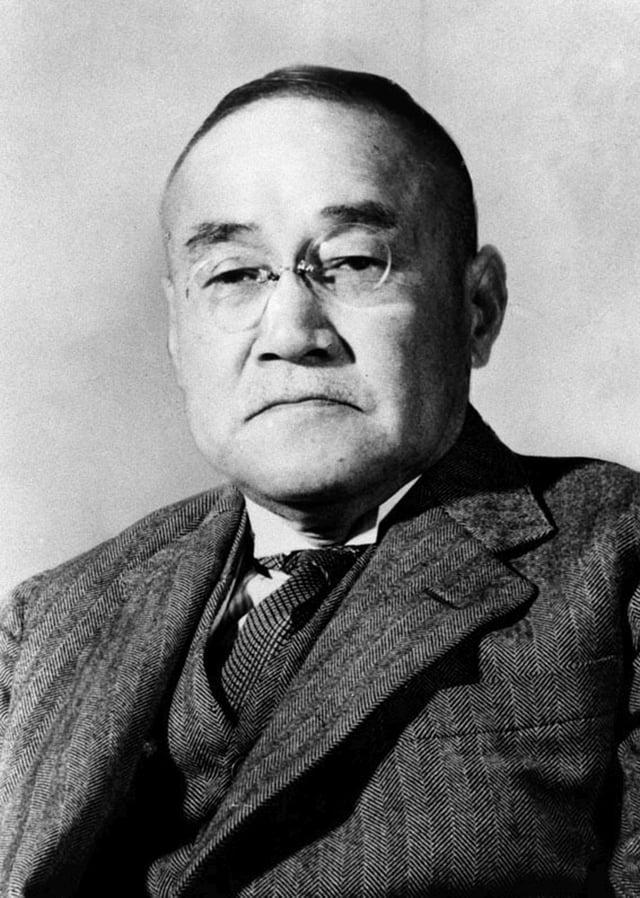
Shigeru Yoshida was one of the longest serving PMs in Japanese history (1946–1947 and 1948–1954).
Shigeru Yoshida served as prime minister in 1946–1947 and 1948–1954, and played a key role in guiding Japan through the occupation.[292] His policies, known as the Yoshida Doctrine, proposed that Japan should forge a tight relationship with the United States and focus on developing the economy rather than pursuing a proactive foreign policy.[293] Yoshida was one of the longest serving prime ministers in Japanese history and the third-longest serving Prime Minister in Post-occupation Japan.[294] Yoshida's Liberal Party merged in 1955 into the new Liberal Democratic Party (LDP),[295] which went on to dominate Japanese politics for the remainder of the Shōwa period.[296]
Although the Japanese economy was in bad shape in the immediate postwar years, an austerity program implemented in 1949 by finance expert Joseph Dodge ended inflation.[297] The Korean War (1950–1953) was a major boon to Japanese business.[298] In 1949 the Yoshida cabinet created the Ministry of International Trade and Industry (MITI) with a mission to promote economic growth through close cooperation between the government and big business. MITI sought successfully to promote manufacturing and heavy industry,[299] and encourage exports.[300] The factors behind Japan's postwar economic growth included technology and quality control techniques imported from the West, close economic and defense cooperation with the United States, non-tariff barriers to imports, restrictions on labor unionization, long work hours, and a generally favorable global economic environment.[301] Japanese corporations successfully retained a loyal and experienced workforce through the system of lifetime employment, which assured their employees a safe job.[302]
By 1955, the Japanese economy had grown beyond prewar levels,[303] and by 1968 it had become the second largest in the world.[304] The GNP expanded at an annual rate of nearly 10% from 1956 until the 1973 oil crisis slowed growth to a still-rapid average annual rate of just over 4% until 1991.[305] Life expectancy rose and Japan's population increased to 123 million by 1990.[306] Ordinary Japanese people became wealthy enough to purchase a wide array of consumer goods. During this period, Japan became the world's largest manufacturer of automobiles and a leading producer of electronics.[307] Japan signed the Plaza Accord in 1985 to depreciate the US dollar against the yen and other currencies. By the end of 1987, the Nikkei stock market index had doubled and the Tokyo Stock Exchange became the largest in the world. During the ensuing economic bubble, stock and real-estate loans grew rapidly.[308]
Japan became a member of the United Nations in 1956 and further cemented its international standing in 1964, when it hosted the Olympic Games in Tokyo.[309] Japan was a close ally of the United States during the Cold War, though this alliance did not have unanimous support from the Japanese people. As requested by the United States, Japan reconstituted its army in 1954 under the name Japan Self-Defense Forces (JSDF), though some Japanese insisted that the very existence of the JSDF was a violation of Article 9 of Japan's constitution.[310] In 1960, hundreds of thousands protested against amendments to the US-Japan Security Treaty.[311] Japan successfully normalized relations with the Soviet Union in 1956, despite an ongoing dispute over the ownership of the Kuril Islands,[312] and with South Korea in 1965, despite an ongoing dispute over the ownership of the islands of Liancourt Rocks.[313] In accordance with US policy, Japan recognized the Republic of China on Taiwan as the legitimate government of China after World War II, though Japan switched its recognition to the People's Republic of China in 1972.[314]
Among cultural developments, the immediate post-occupation period became a golden age for Japanese cinema.[315] The reasons for this include the abolition of government censorship, low film production costs, expanded access to new film techniques and technologies, and huge domestic audiences at a time when other forms of recreation were relatively scarce.[316]
Heisei period (1989–2019)
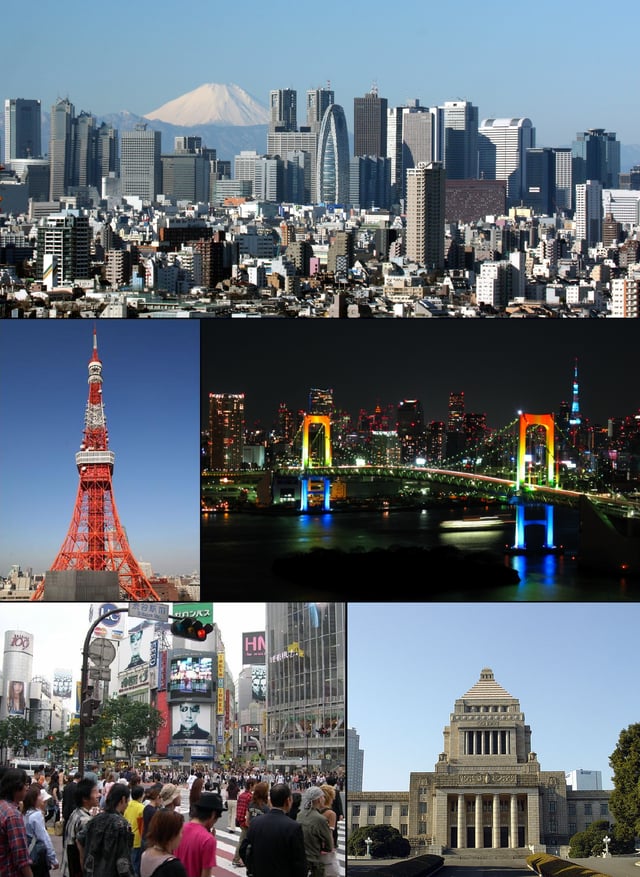
The capital Tokyo in 2010
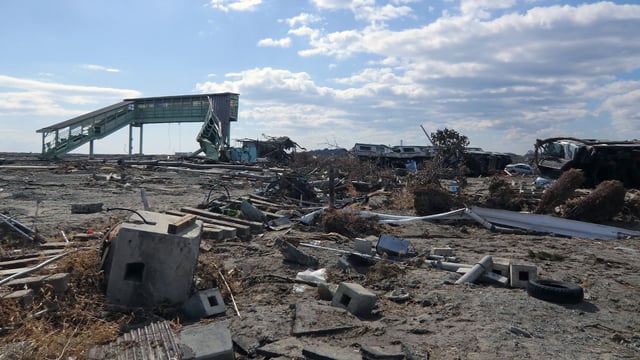
Wreckage at a railway station destroyed during the 2011 earthquake and tsunami
Emperor Akihito's reign began upon the death of his father, Emperor Hirohito. The economic bubble popped in 1989, and stock and land prices plunged as Japan entered a deflationary spiral. Banks found themselves saddled with insurmountable debts that hindered economic recovery.[317] Stagnation worsened as the birthrate declined far below replacement level.[318] The 1990s are often referred to as Japan's Lost Decade.[319] Economic performance was frequently poor in the following decades[320] and the stock market never returned to its pre-1989 highs.[321] Japan's system of lifetime employment largely collapsed and unemployment rates rose.[322] The faltering economy and several corruption scandals weakened the LDP's dominant political position. Japan was nevertheless governed by non-LDP prime ministers only in 1993–1996[323] and 2009–2012.[324]
Japan's dealing with its war legacy has strained international relations. China and Korea have found official apologies, such as those of the Emperor in 1990 and the Murayama Statement of 1995, inadequate or insincere.[325] Nationalist politics have exacerbated this, such as denial of the Nanjing Massacre and other war crimes;[326] revisionist history textbooks, which have provoked protests in East Asia,[327] and frequent visits by Japanese politicians to Yasukuni Shrine, where convicted war criminals are enshrined.[328] Legislation in 2015 expanding the military's role overseas was criticized as a "war bill".[329]
On March 11, 2011, one of the largest earthquakes recorded in Japan occurred in the northeast.[331] The resulting tsunami damaged the nuclear facilities in Fukushima, which experienced a nuclear meltdown and severe radiation leakage.[332] In the 21st century there have been increasing reports on the prevalence of sexlessness among the Japanese, including its byproducts such as a decreasing population, the increasing popularity of sexbots[333] and the herbivore men phenomenon.[334] Some people have blamed the increasing sexlessness in Japanese society on economic insecurity, and others on anaphrodisic government policies.[335]
Reiwa period (2019–)
Emperor Naruhito's reign began upon the abdication of his father, Emperor Akihito, on May 1, 2019.
Social conditions

Social structure of the Edo period
Social stratification in Japan became pronounced during the Yayoi period. Expanding trade and agriculture increased the wealth of society, which was increasingly monopolized by social elites.[36] By 600 AD, a class structure had developed which included court aristocrats, the families of local magnates, commoners, and slaves.[336] Over 90% were commoners, who included farmers, merchants, and artisans.[337] During the late Heian period, the governing elite consisted of three classes. The traditional aristocracy shared power with Buddhist monks and samurai,[337] though the latter became increasingly dominant in the Kamakura and Muromachi periods.[338] These periods witnessed the rise of the merchant class, which diversified into a greater variety of specialized occupations.[339]
Women initially held social and political equality with men,[336] and archaeological evidence suggests a prehistorical preference for female rulers in western Japan. Female Emperors appear in recorded history until the Meiji Constitution declared strict male-only ascension in 1889.[340] Chinese Confucian-style patriarchy was first codified in the 7th–8th centuries with the ritsuryō system,[341] which introduced a patrilineal family register with a male head of household.[342] Women until then had held important roles in government which thereafter gradually diminished, though even in the late Heian period women wielded considerable court influence.[340] Marital customs and many laws governing private property remained gender neutral.[343]
For reasons that are unclear to historians the status of women rapidly deteriorated from the fourteenth century and onwards.[344] Women of all social classes lost the right to own and inherit property and were increasingly viewed as inferior to men.[345] Hideyoshi's land survey of the 1590s further entrenched the status of men as dominant landholders.[346] During the US occupation following World War II , women gained legal equality with men,[347] but faced widespread workplace discrimination. A movement for women's rights led to the passage of an equal employment law in 1986, but by the 1990s women held only 10% of management positions.[348]
Hideyoshi's land survey of the 1590s designated all who cultivated the land as commoners, an act which granted effective freedom to most of Japan's slaves.[155]
The Tokugawa shogunate rigidified long-existent class divisions,[349] placing most of the population into a Neo-Confucian hierarchy of four occupations, with the ruling elite at the top, followed by the peasants who made up 80% of the population, then artisans, and merchants at the bottom.[350] Court nobles,[351] clerics, outcasts, entertainers, and workers of the licensed quarters fell outside this structure.[352] Different legal codes applied to different classes, marriage between classes was prohibited, and towns were subdivided into different class areas.[349] The social stratification had little bearing on economic conditions: many samurai lived in poverty[352] and the wealth of the merchant class grew throughout the period as the commercial economy developed and urbanization grew.[353] The Edo-era social power structure proved untenable and gave way following the Meiji Restoration to one in which commercial power played an increasingly significant political role.[354]
Although all social classes were legally abolished at the start of the Meiji period,[203] income inequality greatly increased.[355] New economic class divisions were formed between capitalist business owners who formed the new middle class, small shopkeepers of the old middle class, the working class in factories, rural landlords, and tenant farmers.[356] The great disparities of income between the classes dissipated during and after World War II, eventually declining to levels that were among the lowest in the industrialized world.[355] Some postwar surveys indicated that up to 90% of Japanese self-identified as being middle class.[357]
Populations of workers in professions considered unclean, such as leatherworkers and those who handled the dead, developed in the 15th and 16th centuries into hereditary outcast communities.[358] These people, later called burakumin, fell outside the Edo-period class structure and suffered discrimination that lasted after the class system was abolished.[359] Though activism has improved the social conditions of those from burakumin backgrounds, discrimination in employment and education lingered into the 21st century.[360]
See also
Bibliography of Japanese history
Economic history of Japan
Higashiyama period
Historiography of Japan
History of East Asia
History of Japanese art
History of Japanese foreign relations Australia–Japan relations Austria–Japan relations Brazil–Japan relations Canada–Japan relations China–Japan relations Foreign relations of Meiji Japan France–Japan relations Germany–Japan relations Greater East Asia Co-Prosperity Sphere, 1930–1945 Greece–Japan relations History of Japan–Korea relations History of Sino-Japanese relations, China India–Japan relations Ireland–Japan relations Israel–Japan relations Italy–Japan relations Japanese foreign policy on Southeast Asia Japan–Mexico relations Japan–Netherlands relations Japan–Portugal relations Japan–Russia relations Japan–South Korea relations Japan–Soviet Union relations Japan–Spain relations Japan–Turkey relations Japan–United Kingdom relations Japan–United States relations
History of manga
History of Tokyo
List of Emperors of Japan
List of Prime Ministers of Japan
List of World Heritage Sites in Japan
Military history of Japan
Politics of Japan
Timeline of Japanese history
Academic journals
Bulletin of the National Museum of Japanese History, in Japanese
Japanese Journal of Religious Studies
Journal of Japanese Studies
Monumenta Nipponica, Japanese studies, in English
Social Science Japan Journal
